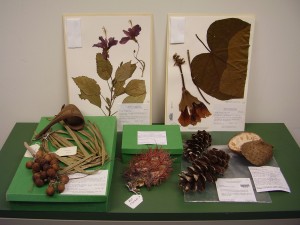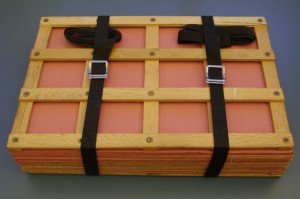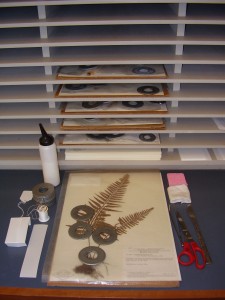Herbarium Specimens Pressed for Posterity
Posted in Science on February 24 2010, by Plant Talk
Staff Preserve More Than 35,000 Plants Each Year
 |
Lisa Vargues is Curatorial Assistant of the Herbarium. |
 Adjacent to The New York Botanical Garden’s Library building stands a 70,000 square-foot treasure chest: the William and Lynda Steere Herbarium. This “library” of over 7.3 million preserved and filed plant specimens is the largest in the Western Hemisphere and considered a crown jewel in the world of botanical research. Roughly 35,000–40,000 specimens arrive here annually from around the world, through gifts, exchanges, and staff collections, and are preserved through a careful process that has not changed for centuries.
Adjacent to The New York Botanical Garden’s Library building stands a 70,000 square-foot treasure chest: the William and Lynda Steere Herbarium. This “library” of over 7.3 million preserved and filed plant specimens is the largest in the Western Hemisphere and considered a crown jewel in the world of botanical research. Roughly 35,000–40,000 specimens arrive here annually from around the world, through gifts, exchanges, and staff collections, and are preserved through a careful process that has not changed for centuries.
A plant’s journey from field to filing cabinet is often a fascinating one. Botanists, including Garden Science staff, travel the globe searching for new and interesting species often in remote regions and using a variety of means of access—sometimes dugout canoes, helicopters, or helium-filled balloons. The journey can be brief yet momentous, such as when a desirable plant springs up near the Garden’s gates or by a New York City parking lot.
 Once a plant is identified for collection, a variety of tools (pruners, trowel, pickaxe) are used to remove a section of the plant consisting of flowers, fruits, leaves, stems, and sometimes roots. The preservation process begins in the field, where botanists rely on the wooden plant press (pictured). Plants are carefully positioned between layers of newspaper and cardboard and left to dry within the tightened wooden grids. At that moment, plants are in a sense “frozen in time,” immortalizing their beauty, form, and stage of growth. Specimen drying techniques can vary depending on location. Garden collectors have placed their presses under a space heater apparatus with a fan, in the desert sun, in a bakery oven, and even in a ship’s boiler room. Drying is usually complete within eight hours. For identification purposes, both sides of a leaf should be visible after pressing.
Once a plant is identified for collection, a variety of tools (pruners, trowel, pickaxe) are used to remove a section of the plant consisting of flowers, fruits, leaves, stems, and sometimes roots. The preservation process begins in the field, where botanists rely on the wooden plant press (pictured). Plants are carefully positioned between layers of newspaper and cardboard and left to dry within the tightened wooden grids. At that moment, plants are in a sense “frozen in time,” immortalizing their beauty, form, and stage of growth. Specimen drying techniques can vary depending on location. Garden collectors have placed their presses under a space heater apparatus with a fan, in the desert sun, in a bakery oven, and even in a ship’s boiler room. Drying is usually complete within eight hours. For identification purposes, both sides of a leaf should be visible after pressing.
Identification is done either straightaway in the field or, if the specimen is outside of a botanist’s expertise, researched later, referring to other experts, keys, and the Herbarium. Once determined, the plant’s scientific name is listed on a label, which also contains a wide range of collection information such as location, habitat, and the collector’s name, resulting in a unique plant “profile.”
Before a pressed specimen can be filed into one of the Herbarium’s 2,000 steel, climate-controlled cabinets to be stored in perpetuity, however, it must be processed by a Specimen Preparation Technician. This step transforms a once-living plant into a permanent museum piece that will ultimately allow scientists to research topics such as environmental change, the biodiversity of an area, medicine, DNA, and ethnobotanical uses.
The work of the Preparation Technician is very engaging as it melds art, science, and exploration onto an 11½- x 16½-inch sheet of paper. The endless variety of plant forms never ceases to fascinate, as do the wonderfully varied botanical and geographical names on the labels. The international and sometimes decades-old newspapers in which the plants have been pressed and delivered are interesting as well, providing glimpses into numerous cultures and, like time capsules, into history.

Preparing or mounting a specimen requires detailed focus on both aesthetic and scientific presentation. The majority of pressed plants are carefully arranged and glued down onto acid-free paper—we use 30 gallons of glue a year!; the identification label is glued onto the lower right corner; and a paper packet is included to contain loose fragments. Wax paper and metal weights (see photo) hold everything in place as the glue dries and, last, the specimen is secured to the sheet with needle and thread. Bulkier items, such as prickly cacti and large fruits, are specially boxed or bagged.
The most challenging aspect is wrangling fluffy seeds and handling very prickly or brittle plants, which often requires gloves, tweezers…and patience!
At the Garden, a team of three full-time and two part-time Specimen Preparation Technicians each mount approximately 50 specimens per day.
While Italian physician and botanist Luca Ghini (1490–1556) is credited with creating the first herbarium, it was Swedish botanist Carl Linnaeus (1707–78) who introduced plant specimen preparation as we know it today. Once pressed and preserved, specimens can last indefinitely, as long as they are carefully stored in a cool, dry, low-light environment. Well-preserved flowers, fruits, and leaves found in the ancient tombs of Egypt’s arid climate attest to the effectiveness of good storage. The oldest specimens at the Garden date back to the late 1600s. Plants collected from the expeditions of Captain Cook and Charles Darwin are also among our collection.
The Herbarium team is currently taking the preservation process further by databasing and imaging the Herbarium collections into the C.V. Starr Virtual Herbarium, providing online accessibility to researchers worldwide. Traditional techniques and modern technology are now united, ensuring that each specimen remains a treasure-trove of information.
Poet William Wordsworth once reflected that “nothing can bring back the hour of splendor in the grass, glory in the flower.” To the contrary, here, in the Steere Herbarium, all that natural splendor and glory are preserved and safeguarded for years to come.
Visit the exhibition, Plants and Fungi: Ten Current Research Stories, in the Library building to learn more about the plant exploration process and to view a fascinating display of mounted specimens.

